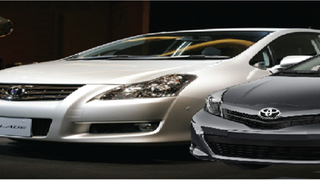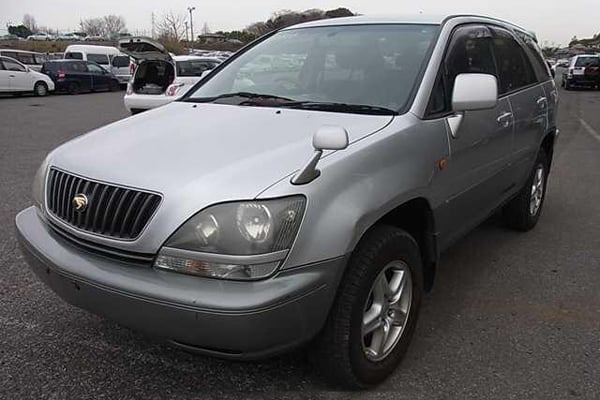
Because these cars were manufactured in 2007/8 whose importation was banned in Uganda, those that were already in the bond have become more expensive. The Blade costs Shs35m while the Auris costs between Shs30m and Shs33m. PHOTO/COURTESY
|Head to head: Toyota Blade vs Auris
What you need to know:
- The main difference between Toyota Blade and Auris is that the Auris was introduced as a small car based on the Corolla, whereas the Blade was marketed as a sturdy and dependable vehicle.
There have been a number of small Toyota hatchbacks that Ugandans have embraced such as the RunX and Alex as well as the Toyota Blade and Auris. Because the last two have an uncanny resemblance, we look at what sets them apart and hopefully help you to choose between the two.
Interior
The Toyota Auris’ interior is perfectly adequate, if a little uninteresting. The Auris’ dashboard is dominated by a flat black plastic that houses the infotainment screen and a clock. The material quality is reasonably good but, again, does not stand out.
All versions, except the entry-level car, come with Toyota’s Touch two seven-inch touchscreen infotainment system, which makes the interior look more hi-tech, while the rest of the dashboard’s controls are sensibly laid-out and easy to operate.
According to www.650.org, the Blade inherits all the practicality of the Corolla but dresses it up in more exclusive packaging. The switchgear and dashboard are thoughtfully laid out and a floating centre control stack keeps everything at hand and extends the Blade’s modern feel.
Black plastics mix in with silver/grey trim and the leather-wrapped steering wheel houses handy audio controls.
The front seats are supportive, have multiple electric adjustments and are finished in black leather. The back seat can take three adults at a push and offers good legroom for a hatchback. Storage space in the hatch is a strength for the Blade.
“General build quality is excellent in the Blade’s interior more than the Auris and there are some classy touches such as dual-zone air conditioning and push-button start. There is a lot to like about the Blade cabin, it is purposeful, spacious and comfortable but not particularly sporty,” the site states.
Exterior
It would take a keen eye to spot the Blade among the populous ranks of the tenth-generation Corollas. However, it is not entirely a wolf in sheep’s clothing. The proportions are the same as the standard Corolla but key differences lay in the Blade’s front and particularly rear lights, which are more striking, with a clear lens.
The front bumper and grille are more bulky and aggressive than the standard Corolla and side skirting adds to the low, athletic demeanour.
Finishing the look is unique Blade badging and the 17-inch five-spoke factory rims that almost fill out the guards. Overall, the Blade design is a mix of the familiar and the foreign which gives the car a more luxury cruiser feel from the driver’s seat, which is at odds with the bold exterior aesthetic and the big, thumping heart under the bonnet.
www.650.org states that as with the new hatchback, the Auris Touring Sports’ bold, dynamic exterior design maximises the aerodynamic benefits of the model’s reduction in overall height, and the dynamic improvements offered by its lower centre of gravity. The new exterior design has an excellent aerodynamic performance.
“The new Auris Touring Sports shares the hatchback’s new frontal design, which combines Toyota’s Under Priority design language with Keen Look headlamp and LED Daytime Running Light (DRL) detailing to give the new wagon a powerful yet elegant road presence,” the site adds.
Torque and power
The Auris Hybrid’s powertrain is the same as that of the Prius, so there is only one engine available; a 1.8-litre petrol with 98bhp. That is aided by an 80bhp electric motor, with power fed through a constantly variable automatic transmission (CVT).
The CVT gearbox can be frustrating since it tends to hold onto engine revs for longer than you would want, which is detrimental to fuel consumption and raises concerns as to how easily the Auris’ claimed fuel economy figures can be realised. Unfortunately, it is the only gearbox Toyota offers with the hybrid.
When you start the car, it defaults to electric power and the petrol engine starts once the acceleration called for is more than the electric motor can handle alone. When the engine is running, it can sound rather overworked, with the engine speed often not matching the velocity you are travelling at.
So, what exactly makes the Blade tick? Instead of taking the turbocharged route that is popular for most modern hot hatchbacks, Toyota has increased engine size to boost power. To achieve this, Toyota has put a 3.5-litre V6 alloy engine into the Blades compact engine bay.
Safety
The grip is also very good once the Blade is up to speed and it will hold on with tenacity even at its limit. Push the Blade too hard and it will understeer but the traction and stability control should save you from total embarrassment. The traction control system is a permanent setting and cannot be turned off which, depending on your viewpoint, is either a good or bad thing.
Other safety features are impressive and include uprated sports brakes to help throw the anchors down and a full complement of eight airbags if things go seriously wrong. There is also hill start assist and electronic brake distribution.
Safety in the Auris is also strong; all models come with the Toyota Safety Sense package as standard. Safety sense features autonomous emergency braking, which can alert the driver or apply the brakes should a collision be detected. The system can also ‘read’ road signs, and display them on the car’s information display.
Verdict
The Blade is a unique car that has an individual blend of luxury, comfort and raw sporting ability. The Blade will have genuine appeal to those looking for a hot hatch but do not want a leery turbocharged model. It will also be on the radar of Toyota badge fans desperate for a late-model performance machine.
But most of all, the Blade will appeal to those who want something familiar and practical such as the Corolla but totally different and original at the same time.
The Auris performs its functions reliably and without fuss, stress or expense. It is also simple to operate. It even scores heavier on account of its fuel sipping skills. It is easy to drive, simple to park and economical to run. This car also maintains its resale value quite well.




